HI5017: Analysis of Management Accounting Systems and Techniques
VerifiedAdded on 2022/10/11
|12
|4267
|24
Report
AI Summary
This report critically analyzes two journal articles on the application of management accounting systems within contemporary companies. The assignment, undertaken as part of the HI5017 Managerial Accounting course, evaluates the relevance and usefulness of techniques such as Activity Based Costing (ABC), Balance Scorecard (BSC), and Total Quality Management (TQM) in aiding managerial decision-making and achieving business goals. The report examines the challenges and limitations of these techniques, highlighting the need for careful consideration of data utilization and the ability to adapt these tools to specific business contexts. It discusses the findings of the first journal, focusing on a multinational manufacturing company's experience with various management accounting tools, and the second journal article which is not included in the provided text. The report emphasizes the importance of aligning management accounting systems with the specific needs and operational characteristics of a business, while also acknowledging the contributions of Western economists and accounting scholars to the field.
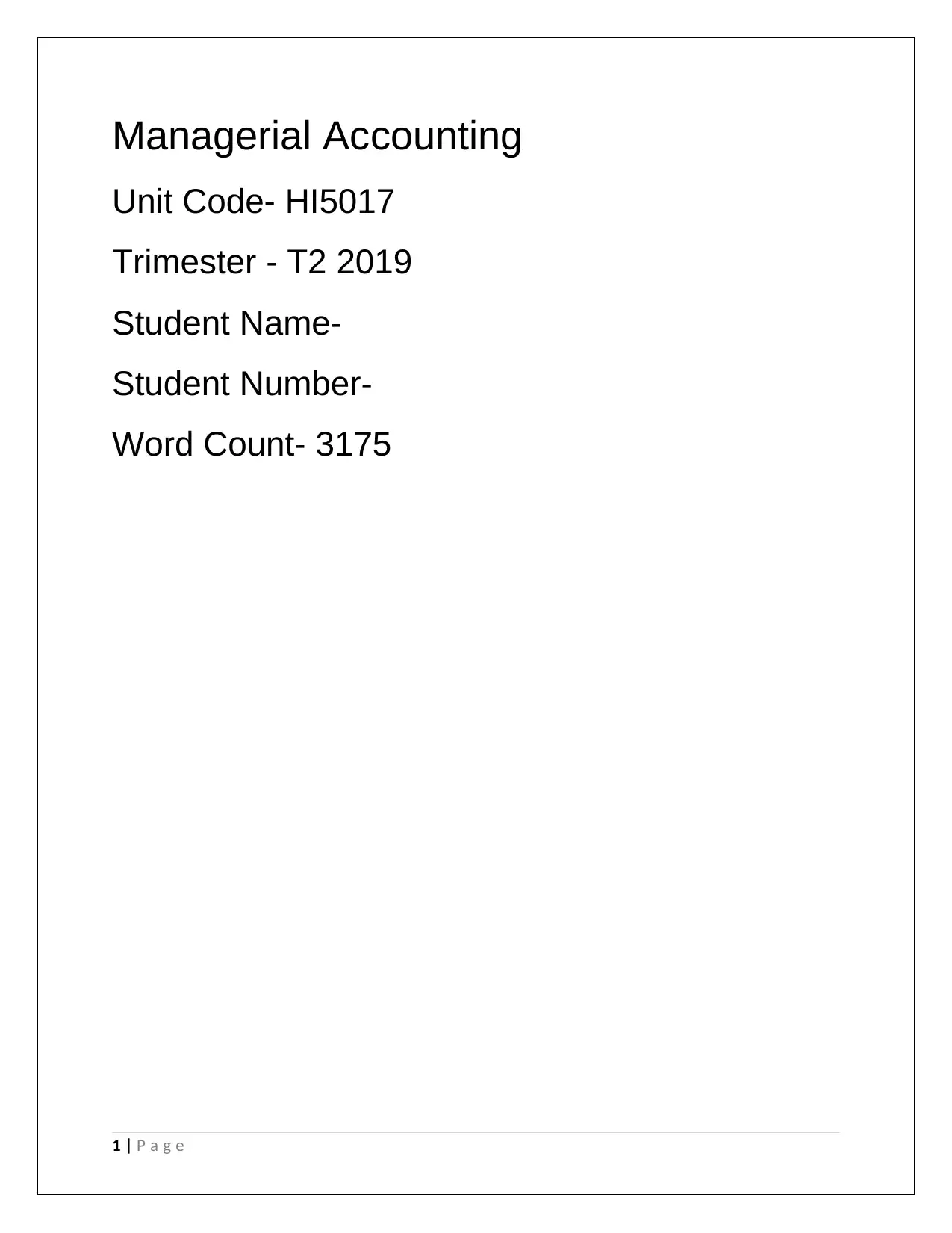
Managerial Accounting
Unit Code- HI5017
Trimester - T2 2019
Student Name-
Student Number-
Word Count- 3175
1 | P a g e
Unit Code- HI5017
Trimester - T2 2019
Student Name-
Student Number-
Word Count- 3175
1 | P a g e
Paraphrase This Document
Need a fresh take? Get an instant paraphrase of this document with our AI Paraphraser
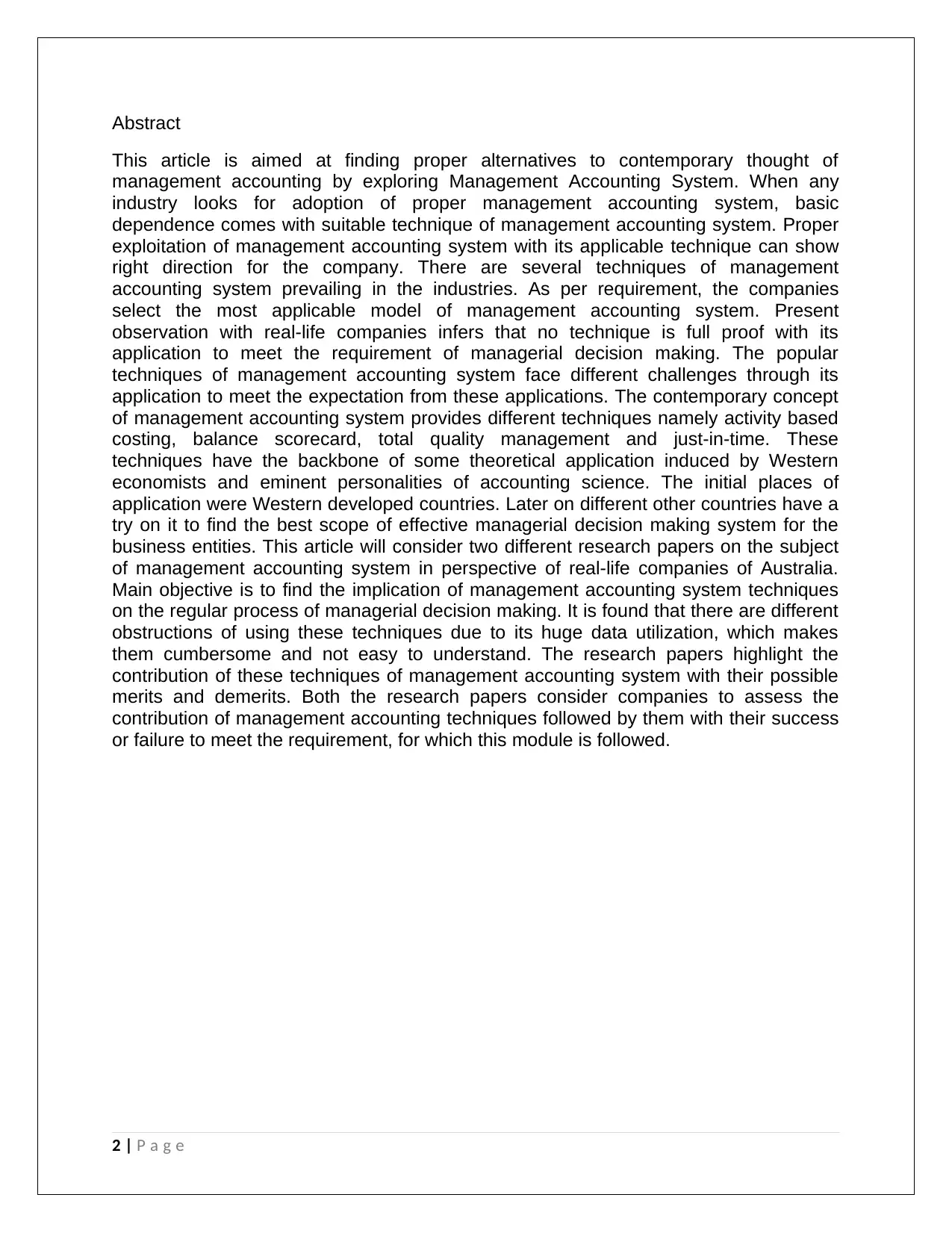
Abstract
This article is aimed at finding proper alternatives to contemporary thought of
management accounting by exploring Management Accounting System. When any
industry looks for adoption of proper management accounting system, basic
dependence comes with suitable technique of management accounting system. Proper
exploitation of management accounting system with its applicable technique can show
right direction for the company. There are several techniques of management
accounting system prevailing in the industries. As per requirement, the companies
select the most applicable model of management accounting system. Present
observation with real-life companies infers that no technique is full proof with its
application to meet the requirement of managerial decision making. The popular
techniques of management accounting system face different challenges through its
application to meet the expectation from these applications. The contemporary concept
of management accounting system provides different techniques namely activity based
costing, balance scorecard, total quality management and just-in-time. These
techniques have the backbone of some theoretical application induced by Western
economists and eminent personalities of accounting science. The initial places of
application were Western developed countries. Later on different other countries have a
try on it to find the best scope of effective managerial decision making system for the
business entities. This article will consider two different research papers on the subject
of management accounting system in perspective of real-life companies of Australia.
Main objective is to find the implication of management accounting system techniques
on the regular process of managerial decision making. It is found that there are different
obstructions of using these techniques due to its huge data utilization, which makes
them cumbersome and not easy to understand. The research papers highlight the
contribution of these techniques of management accounting system with their possible
merits and demerits. Both the research papers consider companies to assess the
contribution of management accounting techniques followed by them with their success
or failure to meet the requirement, for which this module is followed.
2 | P a g e
This article is aimed at finding proper alternatives to contemporary thought of
management accounting by exploring Management Accounting System. When any
industry looks for adoption of proper management accounting system, basic
dependence comes with suitable technique of management accounting system. Proper
exploitation of management accounting system with its applicable technique can show
right direction for the company. There are several techniques of management
accounting system prevailing in the industries. As per requirement, the companies
select the most applicable model of management accounting system. Present
observation with real-life companies infers that no technique is full proof with its
application to meet the requirement of managerial decision making. The popular
techniques of management accounting system face different challenges through its
application to meet the expectation from these applications. The contemporary concept
of management accounting system provides different techniques namely activity based
costing, balance scorecard, total quality management and just-in-time. These
techniques have the backbone of some theoretical application induced by Western
economists and eminent personalities of accounting science. The initial places of
application were Western developed countries. Later on different other countries have a
try on it to find the best scope of effective managerial decision making system for the
business entities. This article will consider two different research papers on the subject
of management accounting system in perspective of real-life companies of Australia.
Main objective is to find the implication of management accounting system techniques
on the regular process of managerial decision making. It is found that there are different
obstructions of using these techniques due to its huge data utilization, which makes
them cumbersome and not easy to understand. The research papers highlight the
contribution of these techniques of management accounting system with their possible
merits and demerits. Both the research papers consider companies to assess the
contribution of management accounting techniques followed by them with their success
or failure to meet the requirement, for which this module is followed.
2 | P a g e
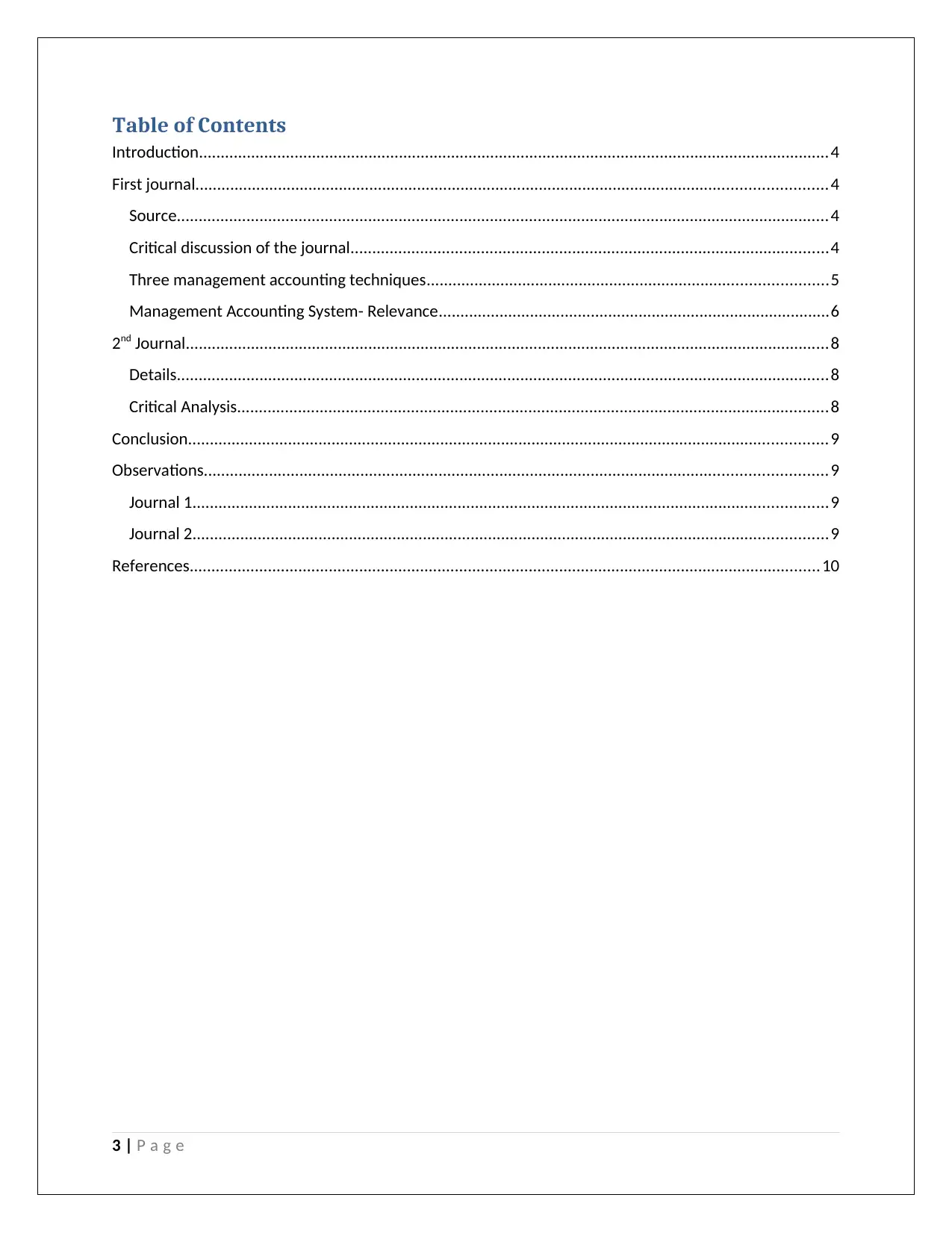
Table of Contents
Introduction.................................................................................................................................................4
First journal.................................................................................................................................................4
Source......................................................................................................................................................4
Critical discussion of the journal..............................................................................................................4
Three management accounting techniques............................................................................................5
Management Accounting System- Relevance..........................................................................................6
2nd Journal....................................................................................................................................................8
Details......................................................................................................................................................8
Critical Analysis........................................................................................................................................8
Conclusion...................................................................................................................................................9
Observations...............................................................................................................................................9
Journal 1..................................................................................................................................................9
Journal 2..................................................................................................................................................9
References.................................................................................................................................................10
3 | P a g e
Introduction.................................................................................................................................................4
First journal.................................................................................................................................................4
Source......................................................................................................................................................4
Critical discussion of the journal..............................................................................................................4
Three management accounting techniques............................................................................................5
Management Accounting System- Relevance..........................................................................................6
2nd Journal....................................................................................................................................................8
Details......................................................................................................................................................8
Critical Analysis........................................................................................................................................8
Conclusion...................................................................................................................................................9
Observations...............................................................................................................................................9
Journal 1..................................................................................................................................................9
Journal 2..................................................................................................................................................9
References.................................................................................................................................................10
3 | P a g e
⊘ This is a preview!⊘
Do you want full access?
Subscribe today to unlock all pages.

Trusted by 1+ million students worldwide
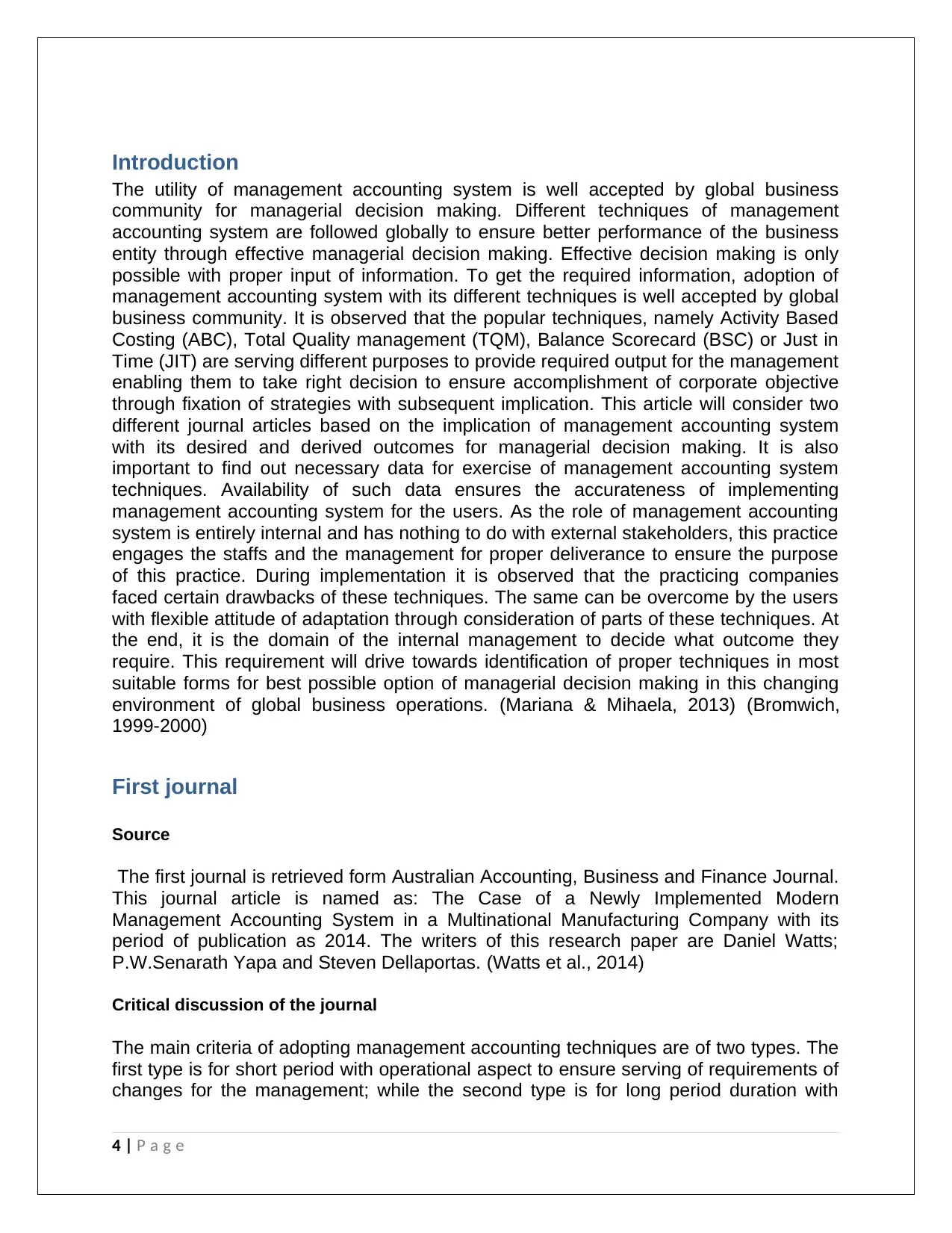
Introduction
The utility of management accounting system is well accepted by global business
community for managerial decision making. Different techniques of management
accounting system are followed globally to ensure better performance of the business
entity through effective managerial decision making. Effective decision making is only
possible with proper input of information. To get the required information, adoption of
management accounting system with its different techniques is well accepted by global
business community. It is observed that the popular techniques, namely Activity Based
Costing (ABC), Total Quality management (TQM), Balance Scorecard (BSC) or Just in
Time (JIT) are serving different purposes to provide required output for the management
enabling them to take right decision to ensure accomplishment of corporate objective
through fixation of strategies with subsequent implication. This article will consider two
different journal articles based on the implication of management accounting system
with its desired and derived outcomes for managerial decision making. It is also
important to find out necessary data for exercise of management accounting system
techniques. Availability of such data ensures the accurateness of implementing
management accounting system for the users. As the role of management accounting
system is entirely internal and has nothing to do with external stakeholders, this practice
engages the staffs and the management for proper deliverance to ensure the purpose
of this practice. During implementation it is observed that the practicing companies
faced certain drawbacks of these techniques. The same can be overcome by the users
with flexible attitude of adaptation through consideration of parts of these techniques. At
the end, it is the domain of the internal management to decide what outcome they
require. This requirement will drive towards identification of proper techniques in most
suitable forms for best possible option of managerial decision making in this changing
environment of global business operations. (Mariana & Mihaela, 2013) (Bromwich,
1999-2000)
First journal
Source
The first journal is retrieved form Australian Accounting, Business and Finance Journal.
This journal article is named as: The Case of a Newly Implemented Modern
Management Accounting System in a Multinational Manufacturing Company with its
period of publication as 2014. The writers of this research paper are Daniel Watts;
P.W.Senarath Yapa and Steven Dellaportas. (Watts et al., 2014)
Critical discussion of the journal
The main criteria of adopting management accounting techniques are of two types. The
first type is for short period with operational aspect to ensure serving of requirements of
changes for the management; while the second type is for long period duration with
4 | P a g e
The utility of management accounting system is well accepted by global business
community for managerial decision making. Different techniques of management
accounting system are followed globally to ensure better performance of the business
entity through effective managerial decision making. Effective decision making is only
possible with proper input of information. To get the required information, adoption of
management accounting system with its different techniques is well accepted by global
business community. It is observed that the popular techniques, namely Activity Based
Costing (ABC), Total Quality management (TQM), Balance Scorecard (BSC) or Just in
Time (JIT) are serving different purposes to provide required output for the management
enabling them to take right decision to ensure accomplishment of corporate objective
through fixation of strategies with subsequent implication. This article will consider two
different journal articles based on the implication of management accounting system
with its desired and derived outcomes for managerial decision making. It is also
important to find out necessary data for exercise of management accounting system
techniques. Availability of such data ensures the accurateness of implementing
management accounting system for the users. As the role of management accounting
system is entirely internal and has nothing to do with external stakeholders, this practice
engages the staffs and the management for proper deliverance to ensure the purpose
of this practice. During implementation it is observed that the practicing companies
faced certain drawbacks of these techniques. The same can be overcome by the users
with flexible attitude of adaptation through consideration of parts of these techniques. At
the end, it is the domain of the internal management to decide what outcome they
require. This requirement will drive towards identification of proper techniques in most
suitable forms for best possible option of managerial decision making in this changing
environment of global business operations. (Mariana & Mihaela, 2013) (Bromwich,
1999-2000)
First journal
Source
The first journal is retrieved form Australian Accounting, Business and Finance Journal.
This journal article is named as: The Case of a Newly Implemented Modern
Management Accounting System in a Multinational Manufacturing Company with its
period of publication as 2014. The writers of this research paper are Daniel Watts;
P.W.Senarath Yapa and Steven Dellaportas. (Watts et al., 2014)
Critical discussion of the journal
The main criteria of adopting management accounting techniques are of two types. The
first type is for short period with operational aspect to ensure serving of requirements of
changes for the management; while the second type is for long period duration with
4 | P a g e
Paraphrase This Document
Need a fresh take? Get an instant paraphrase of this document with our AI Paraphraser
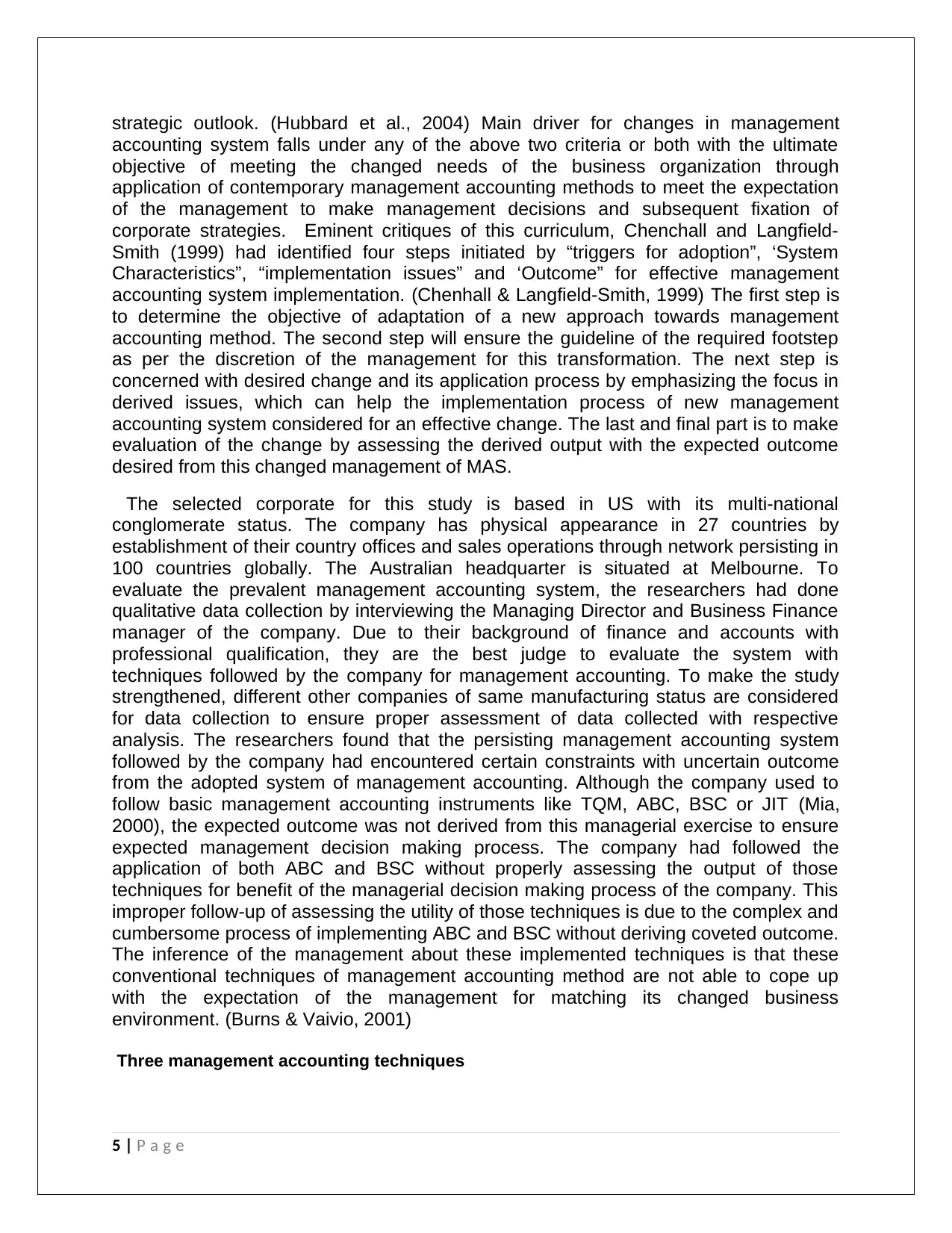
strategic outlook. (Hubbard et al., 2004) Main driver for changes in management
accounting system falls under any of the above two criteria or both with the ultimate
objective of meeting the changed needs of the business organization through
application of contemporary management accounting methods to meet the expectation
of the management to make management decisions and subsequent fixation of
corporate strategies. Eminent critiques of this curriculum, Chenchall and Langfield-
Smith (1999) had identified four steps initiated by “triggers for adoption”, ‘System
Characteristics”, “implementation issues” and ‘Outcome” for effective management
accounting system implementation. (Chenhall & Langfield-Smith, 1999) The first step is
to determine the objective of adaptation of a new approach towards management
accounting method. The second step will ensure the guideline of the required footstep
as per the discretion of the management for this transformation. The next step is
concerned with desired change and its application process by emphasizing the focus in
derived issues, which can help the implementation process of new management
accounting system considered for an effective change. The last and final part is to make
evaluation of the change by assessing the derived output with the expected outcome
desired from this changed management of MAS.
The selected corporate for this study is based in US with its multi-national
conglomerate status. The company has physical appearance in 27 countries by
establishment of their country offices and sales operations through network persisting in
100 countries globally. The Australian headquarter is situated at Melbourne. To
evaluate the prevalent management accounting system, the researchers had done
qualitative data collection by interviewing the Managing Director and Business Finance
manager of the company. Due to their background of finance and accounts with
professional qualification, they are the best judge to evaluate the system with
techniques followed by the company for management accounting. To make the study
strengthened, different other companies of same manufacturing status are considered
for data collection to ensure proper assessment of data collected with respective
analysis. The researchers found that the persisting management accounting system
followed by the company had encountered certain constraints with uncertain outcome
from the adopted system of management accounting. Although the company used to
follow basic management accounting instruments like TQM, ABC, BSC or JIT (Mia,
2000), the expected outcome was not derived from this managerial exercise to ensure
expected management decision making process. The company had followed the
application of both ABC and BSC without properly assessing the output of those
techniques for benefit of the managerial decision making process of the company. This
improper follow-up of assessing the utility of those techniques is due to the complex and
cumbersome process of implementing ABC and BSC without deriving coveted outcome.
The inference of the management about these implemented techniques is that these
conventional techniques of management accounting method are not able to cope up
with the expectation of the management for matching its changed business
environment. (Burns & Vaivio, 2001)
Three management accounting techniques
5 | P a g e
accounting system falls under any of the above two criteria or both with the ultimate
objective of meeting the changed needs of the business organization through
application of contemporary management accounting methods to meet the expectation
of the management to make management decisions and subsequent fixation of
corporate strategies. Eminent critiques of this curriculum, Chenchall and Langfield-
Smith (1999) had identified four steps initiated by “triggers for adoption”, ‘System
Characteristics”, “implementation issues” and ‘Outcome” for effective management
accounting system implementation. (Chenhall & Langfield-Smith, 1999) The first step is
to determine the objective of adaptation of a new approach towards management
accounting method. The second step will ensure the guideline of the required footstep
as per the discretion of the management for this transformation. The next step is
concerned with desired change and its application process by emphasizing the focus in
derived issues, which can help the implementation process of new management
accounting system considered for an effective change. The last and final part is to make
evaluation of the change by assessing the derived output with the expected outcome
desired from this changed management of MAS.
The selected corporate for this study is based in US with its multi-national
conglomerate status. The company has physical appearance in 27 countries by
establishment of their country offices and sales operations through network persisting in
100 countries globally. The Australian headquarter is situated at Melbourne. To
evaluate the prevalent management accounting system, the researchers had done
qualitative data collection by interviewing the Managing Director and Business Finance
manager of the company. Due to their background of finance and accounts with
professional qualification, they are the best judge to evaluate the system with
techniques followed by the company for management accounting. To make the study
strengthened, different other companies of same manufacturing status are considered
for data collection to ensure proper assessment of data collected with respective
analysis. The researchers found that the persisting management accounting system
followed by the company had encountered certain constraints with uncertain outcome
from the adopted system of management accounting. Although the company used to
follow basic management accounting instruments like TQM, ABC, BSC or JIT (Mia,
2000), the expected outcome was not derived from this managerial exercise to ensure
expected management decision making process. The company had followed the
application of both ABC and BSC without properly assessing the output of those
techniques for benefit of the managerial decision making process of the company. This
improper follow-up of assessing the utility of those techniques is due to the complex and
cumbersome process of implementing ABC and BSC without deriving coveted outcome.
The inference of the management about these implemented techniques is that these
conventional techniques of management accounting method are not able to cope up
with the expectation of the management for matching its changed business
environment. (Burns & Vaivio, 2001)
Three management accounting techniques
5 | P a g e
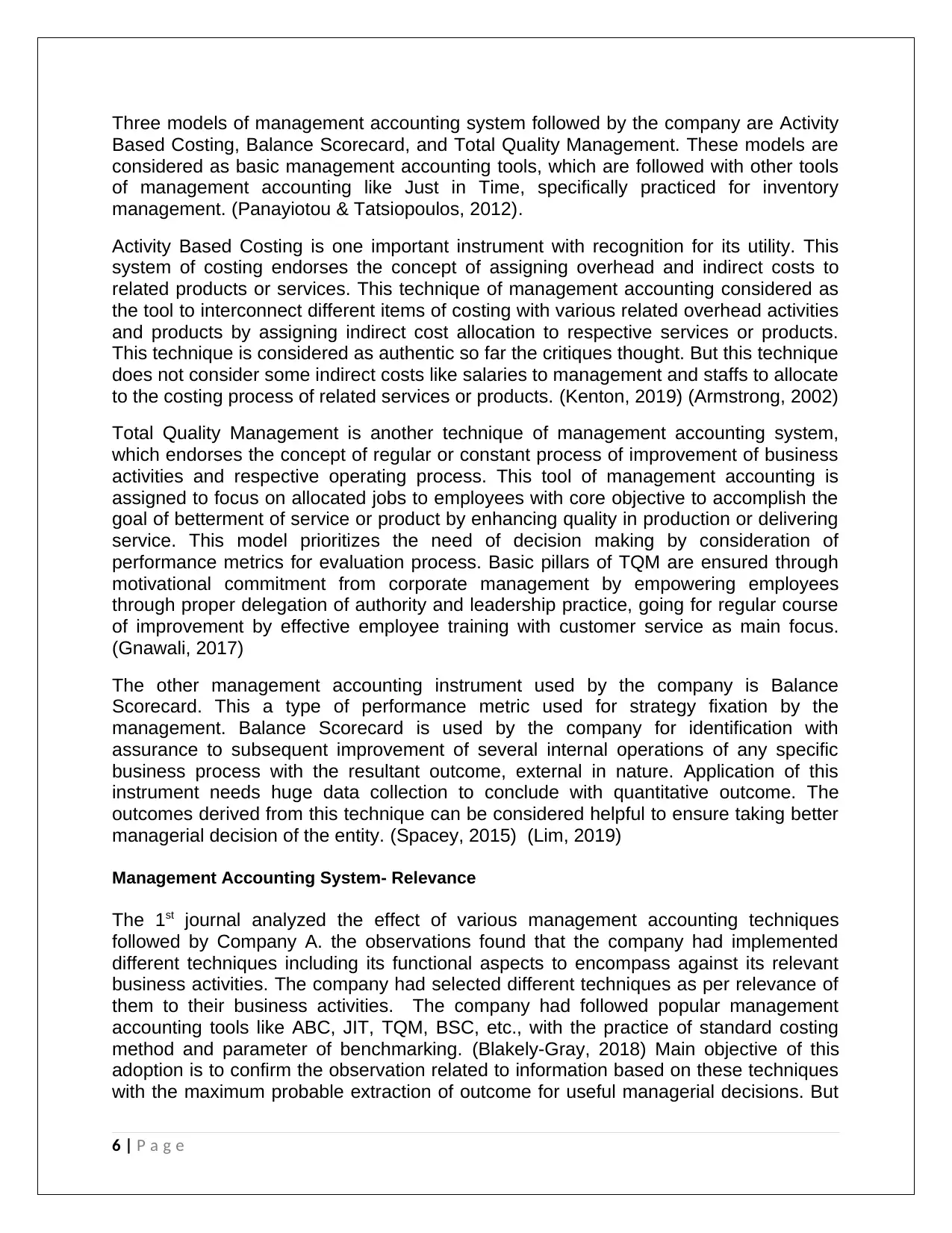
Three models of management accounting system followed by the company are Activity
Based Costing, Balance Scorecard, and Total Quality Management. These models are
considered as basic management accounting tools, which are followed with other tools
of management accounting like Just in Time, specifically practiced for inventory
management. (Panayiotou & Tatsiopoulos, 2012).
Activity Based Costing is one important instrument with recognition for its utility. This
system of costing endorses the concept of assigning overhead and indirect costs to
related products or services. This technique of management accounting considered as
the tool to interconnect different items of costing with various related overhead activities
and products by assigning indirect cost allocation to respective services or products.
This technique is considered as authentic so far the critiques thought. But this technique
does not consider some indirect costs like salaries to management and staffs to allocate
to the costing process of related services or products. (Kenton, 2019) (Armstrong, 2002)
Total Quality Management is another technique of management accounting system,
which endorses the concept of regular or constant process of improvement of business
activities and respective operating process. This tool of management accounting is
assigned to focus on allocated jobs to employees with core objective to accomplish the
goal of betterment of service or product by enhancing quality in production or delivering
service. This model prioritizes the need of decision making by consideration of
performance metrics for evaluation process. Basic pillars of TQM are ensured through
motivational commitment from corporate management by empowering employees
through proper delegation of authority and leadership practice, going for regular course
of improvement by effective employee training with customer service as main focus.
(Gnawali, 2017)
The other management accounting instrument used by the company is Balance
Scorecard. This a type of performance metric used for strategy fixation by the
management. Balance Scorecard is used by the company for identification with
assurance to subsequent improvement of several internal operations of any specific
business process with the resultant outcome, external in nature. Application of this
instrument needs huge data collection to conclude with quantitative outcome. The
outcomes derived from this technique can be considered helpful to ensure taking better
managerial decision of the entity. (Spacey, 2015) (Lim, 2019)
Management Accounting System- Relevance
The 1st journal analyzed the effect of various management accounting techniques
followed by Company A. the observations found that the company had implemented
different techniques including its functional aspects to encompass against its relevant
business activities. The company had selected different techniques as per relevance of
them to their business activities. The company had followed popular management
accounting tools like ABC, JIT, TQM, BSC, etc., with the practice of standard costing
method and parameter of benchmarking. (Blakely-Gray, 2018) Main objective of this
adoption is to confirm the observation related to information based on these techniques
with the maximum probable extraction of outcome for useful managerial decisions. But
6 | P a g e
Based Costing, Balance Scorecard, and Total Quality Management. These models are
considered as basic management accounting tools, which are followed with other tools
of management accounting like Just in Time, specifically practiced for inventory
management. (Panayiotou & Tatsiopoulos, 2012).
Activity Based Costing is one important instrument with recognition for its utility. This
system of costing endorses the concept of assigning overhead and indirect costs to
related products or services. This technique of management accounting considered as
the tool to interconnect different items of costing with various related overhead activities
and products by assigning indirect cost allocation to respective services or products.
This technique is considered as authentic so far the critiques thought. But this technique
does not consider some indirect costs like salaries to management and staffs to allocate
to the costing process of related services or products. (Kenton, 2019) (Armstrong, 2002)
Total Quality Management is another technique of management accounting system,
which endorses the concept of regular or constant process of improvement of business
activities and respective operating process. This tool of management accounting is
assigned to focus on allocated jobs to employees with core objective to accomplish the
goal of betterment of service or product by enhancing quality in production or delivering
service. This model prioritizes the need of decision making by consideration of
performance metrics for evaluation process. Basic pillars of TQM are ensured through
motivational commitment from corporate management by empowering employees
through proper delegation of authority and leadership practice, going for regular course
of improvement by effective employee training with customer service as main focus.
(Gnawali, 2017)
The other management accounting instrument used by the company is Balance
Scorecard. This a type of performance metric used for strategy fixation by the
management. Balance Scorecard is used by the company for identification with
assurance to subsequent improvement of several internal operations of any specific
business process with the resultant outcome, external in nature. Application of this
instrument needs huge data collection to conclude with quantitative outcome. The
outcomes derived from this technique can be considered helpful to ensure taking better
managerial decision of the entity. (Spacey, 2015) (Lim, 2019)
Management Accounting System- Relevance
The 1st journal analyzed the effect of various management accounting techniques
followed by Company A. the observations found that the company had implemented
different techniques including its functional aspects to encompass against its relevant
business activities. The company had selected different techniques as per relevance of
them to their business activities. The company had followed popular management
accounting tools like ABC, JIT, TQM, BSC, etc., with the practice of standard costing
method and parameter of benchmarking. (Blakely-Gray, 2018) Main objective of this
adoption is to confirm the observation related to information based on these techniques
with the maximum probable extraction of outcome for useful managerial decisions. But
6 | P a g e
⊘ This is a preview!⊘
Do you want full access?
Subscribe today to unlock all pages.

Trusted by 1+ million students worldwide

adoption of those techniques had not shown coveted result for the company. Main
reason is the type of business of that company. The company practiced manufacturing
operation, which was simple in nature with exploitation of limited raw resources and
simple ways to perform its production activities. This business did not need the complex
nature of ABC and TQM technique including other practiced techniques like BSC and
some features of JIT. (Woodruff, 2019) The features of these adopted techniques are
linked with inter-relation with the connection of outcomes of different techniques
prevailing in the system. This flow chart of use and subsequent outcome has made the
adopted model very complex with its cumbersome presentation and the users have not
found it user-friendly. With the alternative thought, the management discovered useful
way by selecting some main aspects of these techniques and subsequently the practice
of management accounting of the company has refurbished the practice of
management accounting system with selection of respective useful parts of the
techniques. Company A had the thought to identify useful drivers of different business
activities from the viewpoint of operational performance of the company. Main areas of
concentration were allocating overheads, exercising some significant scorecards and
benchmarking activities in internal and external environments, with application of JIT in
some level of stock management. This application was followed by the application of
TQM to have safety of the operations for the relevant stakeholders. (KOOTANAEE et
al., 2013) (Surum, n.d) (Woodruff, 2018)
The company has insisted on SAP R/3 for its accounting practices. This accounting
software has certain level of management accounting practices. But the same was not
useful for the company. Hence, the company has to depend upon other conventional
management accounting system techniques to ensure effective managerial decision
making for the business. This research is based on interview of two top personnel of the
company, the managing Director and the Business Finance Manager. Both of them
were professionally qualified accounting personals and could well understand the need
of implication of management accounting models for the company considering its
usefulness to ensure effective type of managerial decision making. Both of them had
urged for a customized system of management accounting practice by identifying the
useful part of these techniques available in the practice of management accounting.
Chenchall and Langfield-Smith (1999) had urged in their article about the adaptation of
any system in any business perspective, which is mainly depending upon the
knowledge of that system with customization of them to look for desired level of output.
For Company A, the inference was drawn that the selection of different management
accounting techniques implemented by the management made the scenario complex
and critical for the users for respective desired outcome. This situation had made the
management to think of a rollback of the exercised practice by replacing a new tailor-
made system known as “multi-level variance distribution”. This technique has endorsed
the need of practicing MAS with the determination of variances developed through
tracking of KPIs and consequential budgetary information. This situation drove the practice
towards resultant allocation of these drivers to allied business activities in their Point of Sales or
POS entities. This research paper, based on consideration of Company A, had inferred that
standard techniques of management accounting model was not able to produce coveted output
to meet the requirements of the company. The reason might be identified as the shortcoming of
7 | P a g e
reason is the type of business of that company. The company practiced manufacturing
operation, which was simple in nature with exploitation of limited raw resources and
simple ways to perform its production activities. This business did not need the complex
nature of ABC and TQM technique including other practiced techniques like BSC and
some features of JIT. (Woodruff, 2019) The features of these adopted techniques are
linked with inter-relation with the connection of outcomes of different techniques
prevailing in the system. This flow chart of use and subsequent outcome has made the
adopted model very complex with its cumbersome presentation and the users have not
found it user-friendly. With the alternative thought, the management discovered useful
way by selecting some main aspects of these techniques and subsequently the practice
of management accounting of the company has refurbished the practice of
management accounting system with selection of respective useful parts of the
techniques. Company A had the thought to identify useful drivers of different business
activities from the viewpoint of operational performance of the company. Main areas of
concentration were allocating overheads, exercising some significant scorecards and
benchmarking activities in internal and external environments, with application of JIT in
some level of stock management. This application was followed by the application of
TQM to have safety of the operations for the relevant stakeholders. (KOOTANAEE et
al., 2013) (Surum, n.d) (Woodruff, 2018)
The company has insisted on SAP R/3 for its accounting practices. This accounting
software has certain level of management accounting practices. But the same was not
useful for the company. Hence, the company has to depend upon other conventional
management accounting system techniques to ensure effective managerial decision
making for the business. This research is based on interview of two top personnel of the
company, the managing Director and the Business Finance Manager. Both of them
were professionally qualified accounting personals and could well understand the need
of implication of management accounting models for the company considering its
usefulness to ensure effective type of managerial decision making. Both of them had
urged for a customized system of management accounting practice by identifying the
useful part of these techniques available in the practice of management accounting.
Chenchall and Langfield-Smith (1999) had urged in their article about the adaptation of
any system in any business perspective, which is mainly depending upon the
knowledge of that system with customization of them to look for desired level of output.
For Company A, the inference was drawn that the selection of different management
accounting techniques implemented by the management made the scenario complex
and critical for the users for respective desired outcome. This situation had made the
management to think of a rollback of the exercised practice by replacing a new tailor-
made system known as “multi-level variance distribution”. This technique has endorsed
the need of practicing MAS with the determination of variances developed through
tracking of KPIs and consequential budgetary information. This situation drove the practice
towards resultant allocation of these drivers to allied business activities in their Point of Sales or
POS entities. This research paper, based on consideration of Company A, had inferred that
standard techniques of management accounting model was not able to produce coveted output
to meet the requirements of the company. The reason might be identified as the shortcoming of
7 | P a g e
Paraphrase This Document
Need a fresh take? Get an instant paraphrase of this document with our AI Paraphraser

strategy fixation with cumbersome feedback from the outcomes of conventional management
accounting techniques followed by the company.
2nd Journal
Details
The second journal considered for this article is: Implementation of the Activity-Based Costing
Model for a Farm: An Australian Case; published in Journal of Applied Management Accounting
research in 2016. This journal article is written by Lu Cedric; V G Sridharan; Michael S C Tse.
This article has emphasized on the application of ABC in an agricultural farm of Australia to
assess their costing operation for agricultural products with the merits and demerits of the
applied system of ABC to conclude effectively for managerial decision making. (Lu et al.,
Summer 2016)
Critical Analysis
This research is initiated with the driver of statutory compliance imposed by International
Accounting Standard Board through its standard IAS 41, which requires measurement of all
agricultural products and biological assets at fair value. This standard made the concept of
historical costing obsolete for these products. (Bosch et al., 2012)
Costing is an important issue in agricultural products with its inherent challenges due to
vulnerable nature of products. Present trend of using technology in agricultural business
replaced old practice of manual labor in developed countries. This practice leads to allocation of
different overhead costs in the product cost and the farm through the application of ABC costing
method would serve their purpose for proper identification of product cost with right
apportionment of overhead costs to the product cost. The main goal of this research is to
determine the applicability of ABC model in the farm situated at the state of Victoria in Australia.
The legal status of the farm was as family owned, engaging in production and sales of flowers,
plants and berries. (Schnitkey & Sonka, 18986) (Shields & Young, 1989)
The study revealed with the technical issues related to data availability. ABC model needs huge
data to produce coveted results. While implementing ABC model, the management had started
exercise of developing data management by considering some heuristics to overcome the
limitation of data. We can consider the example of considering sales volume as an alternative
measure of production volume to allocate for activity costs. This step may face some negative
impact on the data reliability with virtual impact on costing practice. The lack of proper data bank
is due to less awareness of management with subsequent lesser investment in accounting
system. The company used to maintain their business records earlier manually. While
implementing the computerized system, lack of data enforces difficulties for strong information
system. The other aspects of implementing ABC model was the reliability of output featured
under different operating environments like weather. This practice of ABC can give idea about
the product cost, which may mislead the users due to different conditions of operation. This may
happen due to non-consideration of extreme conditions of operation with respective activities
and resources related to this operation. These specific conditions were not considered in the
ABC model. There are two limitations observed. The first one is the data related to activities are
based on the estimated feedback of the owners without any authentic information system
8 | P a g e
accounting techniques followed by the company.
2nd Journal
Details
The second journal considered for this article is: Implementation of the Activity-Based Costing
Model for a Farm: An Australian Case; published in Journal of Applied Management Accounting
research in 2016. This journal article is written by Lu Cedric; V G Sridharan; Michael S C Tse.
This article has emphasized on the application of ABC in an agricultural farm of Australia to
assess their costing operation for agricultural products with the merits and demerits of the
applied system of ABC to conclude effectively for managerial decision making. (Lu et al.,
Summer 2016)
Critical Analysis
This research is initiated with the driver of statutory compliance imposed by International
Accounting Standard Board through its standard IAS 41, which requires measurement of all
agricultural products and biological assets at fair value. This standard made the concept of
historical costing obsolete for these products. (Bosch et al., 2012)
Costing is an important issue in agricultural products with its inherent challenges due to
vulnerable nature of products. Present trend of using technology in agricultural business
replaced old practice of manual labor in developed countries. This practice leads to allocation of
different overhead costs in the product cost and the farm through the application of ABC costing
method would serve their purpose for proper identification of product cost with right
apportionment of overhead costs to the product cost. The main goal of this research is to
determine the applicability of ABC model in the farm situated at the state of Victoria in Australia.
The legal status of the farm was as family owned, engaging in production and sales of flowers,
plants and berries. (Schnitkey & Sonka, 18986) (Shields & Young, 1989)
The study revealed with the technical issues related to data availability. ABC model needs huge
data to produce coveted results. While implementing ABC model, the management had started
exercise of developing data management by considering some heuristics to overcome the
limitation of data. We can consider the example of considering sales volume as an alternative
measure of production volume to allocate for activity costs. This step may face some negative
impact on the data reliability with virtual impact on costing practice. The lack of proper data bank
is due to less awareness of management with subsequent lesser investment in accounting
system. The company used to maintain their business records earlier manually. While
implementing the computerized system, lack of data enforces difficulties for strong information
system. The other aspects of implementing ABC model was the reliability of output featured
under different operating environments like weather. This practice of ABC can give idea about
the product cost, which may mislead the users due to different conditions of operation. This may
happen due to non-consideration of extreme conditions of operation with respective activities
and resources related to this operation. These specific conditions were not considered in the
ABC model. There are two limitations observed. The first one is the data related to activities are
based on the estimated feedback of the owners without any authentic information system
8 | P a g e
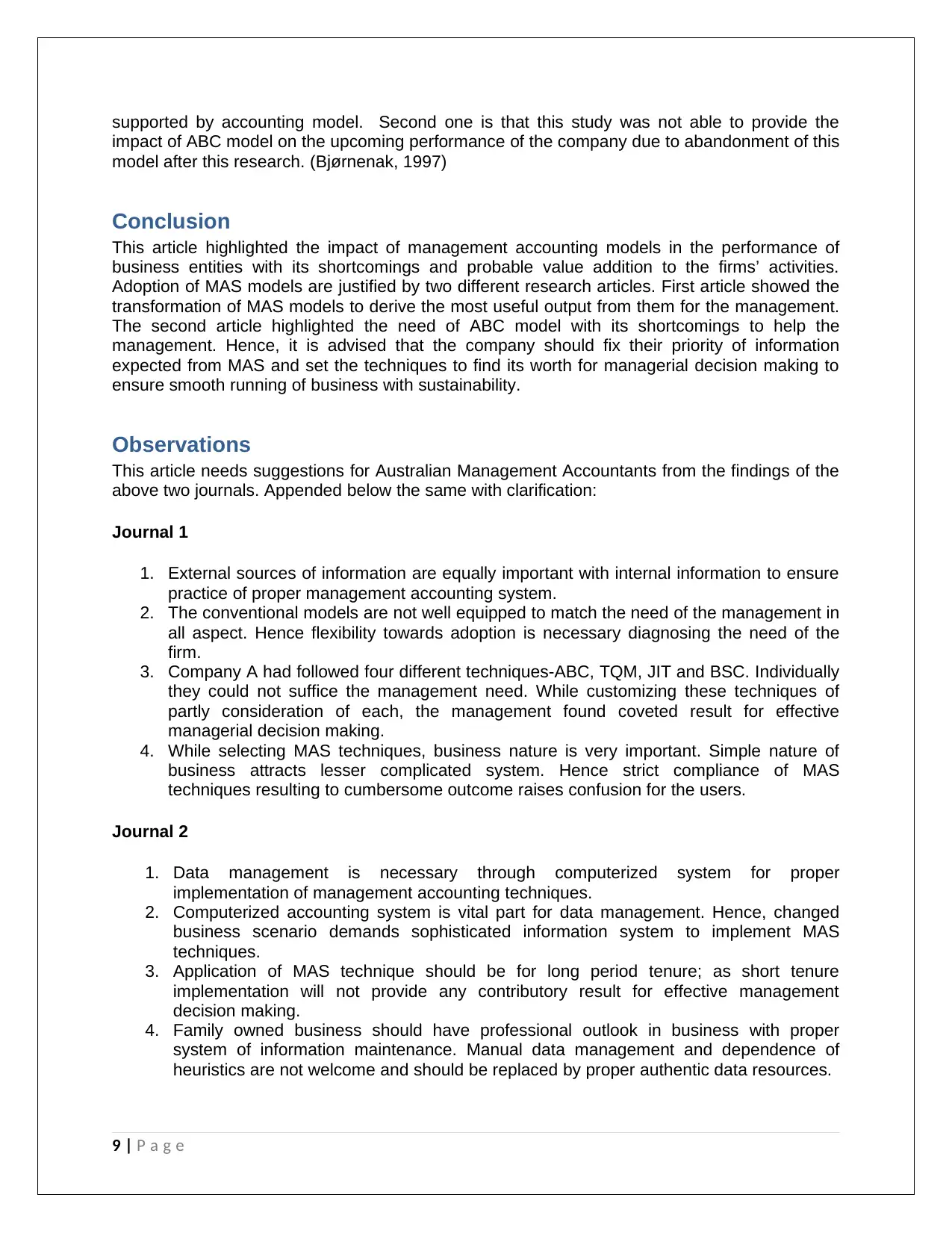
supported by accounting model. Second one is that this study was not able to provide the
impact of ABC model on the upcoming performance of the company due to abandonment of this
model after this research. (Bjørnenak, 1997)
Conclusion
This article highlighted the impact of management accounting models in the performance of
business entities with its shortcomings and probable value addition to the firms’ activities.
Adoption of MAS models are justified by two different research articles. First article showed the
transformation of MAS models to derive the most useful output from them for the management.
The second article highlighted the need of ABC model with its shortcomings to help the
management. Hence, it is advised that the company should fix their priority of information
expected from MAS and set the techniques to find its worth for managerial decision making to
ensure smooth running of business with sustainability.
Observations
This article needs suggestions for Australian Management Accountants from the findings of the
above two journals. Appended below the same with clarification:
Journal 1
1. External sources of information are equally important with internal information to ensure
practice of proper management accounting system.
2. The conventional models are not well equipped to match the need of the management in
all aspect. Hence flexibility towards adoption is necessary diagnosing the need of the
firm.
3. Company A had followed four different techniques-ABC, TQM, JIT and BSC. Individually
they could not suffice the management need. While customizing these techniques of
partly consideration of each, the management found coveted result for effective
managerial decision making.
4. While selecting MAS techniques, business nature is very important. Simple nature of
business attracts lesser complicated system. Hence strict compliance of MAS
techniques resulting to cumbersome outcome raises confusion for the users.
Journal 2
1. Data management is necessary through computerized system for proper
implementation of management accounting techniques.
2. Computerized accounting system is vital part for data management. Hence, changed
business scenario demands sophisticated information system to implement MAS
techniques.
3. Application of MAS technique should be for long period tenure; as short tenure
implementation will not provide any contributory result for effective management
decision making.
4. Family owned business should have professional outlook in business with proper
system of information maintenance. Manual data management and dependence of
heuristics are not welcome and should be replaced by proper authentic data resources.
9 | P a g e
impact of ABC model on the upcoming performance of the company due to abandonment of this
model after this research. (Bjørnenak, 1997)
Conclusion
This article highlighted the impact of management accounting models in the performance of
business entities with its shortcomings and probable value addition to the firms’ activities.
Adoption of MAS models are justified by two different research articles. First article showed the
transformation of MAS models to derive the most useful output from them for the management.
The second article highlighted the need of ABC model with its shortcomings to help the
management. Hence, it is advised that the company should fix their priority of information
expected from MAS and set the techniques to find its worth for managerial decision making to
ensure smooth running of business with sustainability.
Observations
This article needs suggestions for Australian Management Accountants from the findings of the
above two journals. Appended below the same with clarification:
Journal 1
1. External sources of information are equally important with internal information to ensure
practice of proper management accounting system.
2. The conventional models are not well equipped to match the need of the management in
all aspect. Hence flexibility towards adoption is necessary diagnosing the need of the
firm.
3. Company A had followed four different techniques-ABC, TQM, JIT and BSC. Individually
they could not suffice the management need. While customizing these techniques of
partly consideration of each, the management found coveted result for effective
managerial decision making.
4. While selecting MAS techniques, business nature is very important. Simple nature of
business attracts lesser complicated system. Hence strict compliance of MAS
techniques resulting to cumbersome outcome raises confusion for the users.
Journal 2
1. Data management is necessary through computerized system for proper
implementation of management accounting techniques.
2. Computerized accounting system is vital part for data management. Hence, changed
business scenario demands sophisticated information system to implement MAS
techniques.
3. Application of MAS technique should be for long period tenure; as short tenure
implementation will not provide any contributory result for effective management
decision making.
4. Family owned business should have professional outlook in business with proper
system of information maintenance. Manual data management and dependence of
heuristics are not welcome and should be replaced by proper authentic data resources.
9 | P a g e
⊘ This is a preview!⊘
Do you want full access?
Subscribe today to unlock all pages.

Trusted by 1+ million students worldwide
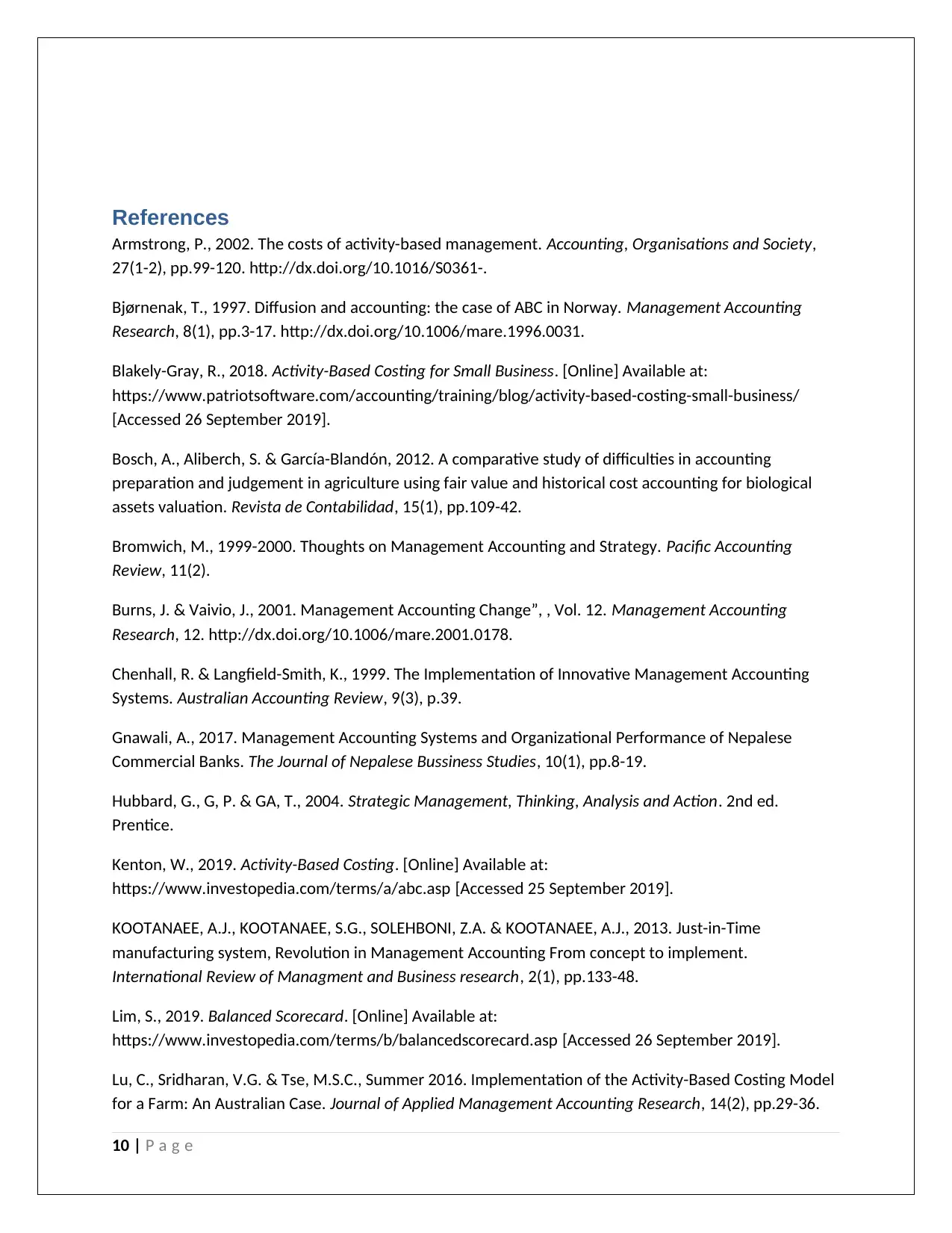
References
Armstrong, P., 2002. The costs of activity-based management. Accounting, Organisations and Society,
27(1-2), pp.99-120. http://dx.doi.org/10.1016/S0361-.
Bjørnenak, T., 1997. Diffusion and accounting: the case of ABC in Norway. Management Accounting
Research, 8(1), pp.3-17. http://dx.doi.org/10.1006/mare.1996.0031.
Blakely-Gray, R., 2018. Activity-Based Costing for Small Business. [Online] Available at:
https://www.patriotsoftware.com/accounting/training/blog/activity-based-costing-small-business/
[Accessed 26 September 2019].
Bosch, A., Aliberch, S. & García-Blandón, 2012. A comparative study of difficulties in accounting
preparation and judgement in agriculture using fair value and historical cost accounting for biological
assets valuation. Revista de Contabilidad, 15(1), pp.109-42.
Bromwich, M., 1999-2000. Thoughts on Management Accounting and Strategy. Pacific Accounting
Review, 11(2).
Burns, J. & Vaivio, J., 2001. Management Accounting Change”, , Vol. 12. Management Accounting
Research, 12. http://dx.doi.org/10.1006/mare.2001.0178.
Chenhall, R. & Langfield-Smith, K., 1999. The Implementation of Innovative Management Accounting
Systems. Australian Accounting Review, 9(3), p.39.
Gnawali, A., 2017. Management Accounting Systems and Organizational Performance of Nepalese
Commercial Banks. The Journal of Nepalese Bussiness Studies, 10(1), pp.8-19.
Hubbard, G., G, P. & GA, T., 2004. Strategic Management, Thinking, Analysis and Action. 2nd ed.
Prentice.
Kenton, W., 2019. Activity-Based Costing. [Online] Available at:
https://www.investopedia.com/terms/a/abc.asp [Accessed 25 September 2019].
KOOTANAEE, A.J., KOOTANAEE, S.G., SOLEHBONI, Z.A. & KOOTANAEE, A.J., 2013. Just-in-Time
manufacturing system, Revolution in Management Accounting From concept to implement.
International Review of Managment and Business research, 2(1), pp.133-48.
Lim, S., 2019. Balanced Scorecard. [Online] Available at:
https://www.investopedia.com/terms/b/balancedscorecard.asp [Accessed 26 September 2019].
Lu, C., Sridharan, V.G. & Tse, M.S.C., Summer 2016. Implementation of the Activity-Based Costing Model
for a Farm: An Australian Case. Journal of Applied Management Accounting Research, 14(2), pp.29-36.
10 | P a g e
Armstrong, P., 2002. The costs of activity-based management. Accounting, Organisations and Society,
27(1-2), pp.99-120. http://dx.doi.org/10.1016/S0361-.
Bjørnenak, T., 1997. Diffusion and accounting: the case of ABC in Norway. Management Accounting
Research, 8(1), pp.3-17. http://dx.doi.org/10.1006/mare.1996.0031.
Blakely-Gray, R., 2018. Activity-Based Costing for Small Business. [Online] Available at:
https://www.patriotsoftware.com/accounting/training/blog/activity-based-costing-small-business/
[Accessed 26 September 2019].
Bosch, A., Aliberch, S. & García-Blandón, 2012. A comparative study of difficulties in accounting
preparation and judgement in agriculture using fair value and historical cost accounting for biological
assets valuation. Revista de Contabilidad, 15(1), pp.109-42.
Bromwich, M., 1999-2000. Thoughts on Management Accounting and Strategy. Pacific Accounting
Review, 11(2).
Burns, J. & Vaivio, J., 2001. Management Accounting Change”, , Vol. 12. Management Accounting
Research, 12. http://dx.doi.org/10.1006/mare.2001.0178.
Chenhall, R. & Langfield-Smith, K., 1999. The Implementation of Innovative Management Accounting
Systems. Australian Accounting Review, 9(3), p.39.
Gnawali, A., 2017. Management Accounting Systems and Organizational Performance of Nepalese
Commercial Banks. The Journal of Nepalese Bussiness Studies, 10(1), pp.8-19.
Hubbard, G., G, P. & GA, T., 2004. Strategic Management, Thinking, Analysis and Action. 2nd ed.
Prentice.
Kenton, W., 2019. Activity-Based Costing. [Online] Available at:
https://www.investopedia.com/terms/a/abc.asp [Accessed 25 September 2019].
KOOTANAEE, A.J., KOOTANAEE, S.G., SOLEHBONI, Z.A. & KOOTANAEE, A.J., 2013. Just-in-Time
manufacturing system, Revolution in Management Accounting From concept to implement.
International Review of Managment and Business research, 2(1), pp.133-48.
Lim, S., 2019. Balanced Scorecard. [Online] Available at:
https://www.investopedia.com/terms/b/balancedscorecard.asp [Accessed 26 September 2019].
Lu, C., Sridharan, V.G. & Tse, M.S.C., Summer 2016. Implementation of the Activity-Based Costing Model
for a Farm: An Australian Case. Journal of Applied Management Accounting Research, 14(2), pp.29-36.
10 | P a g e
Paraphrase This Document
Need a fresh take? Get an instant paraphrase of this document with our AI Paraphraser
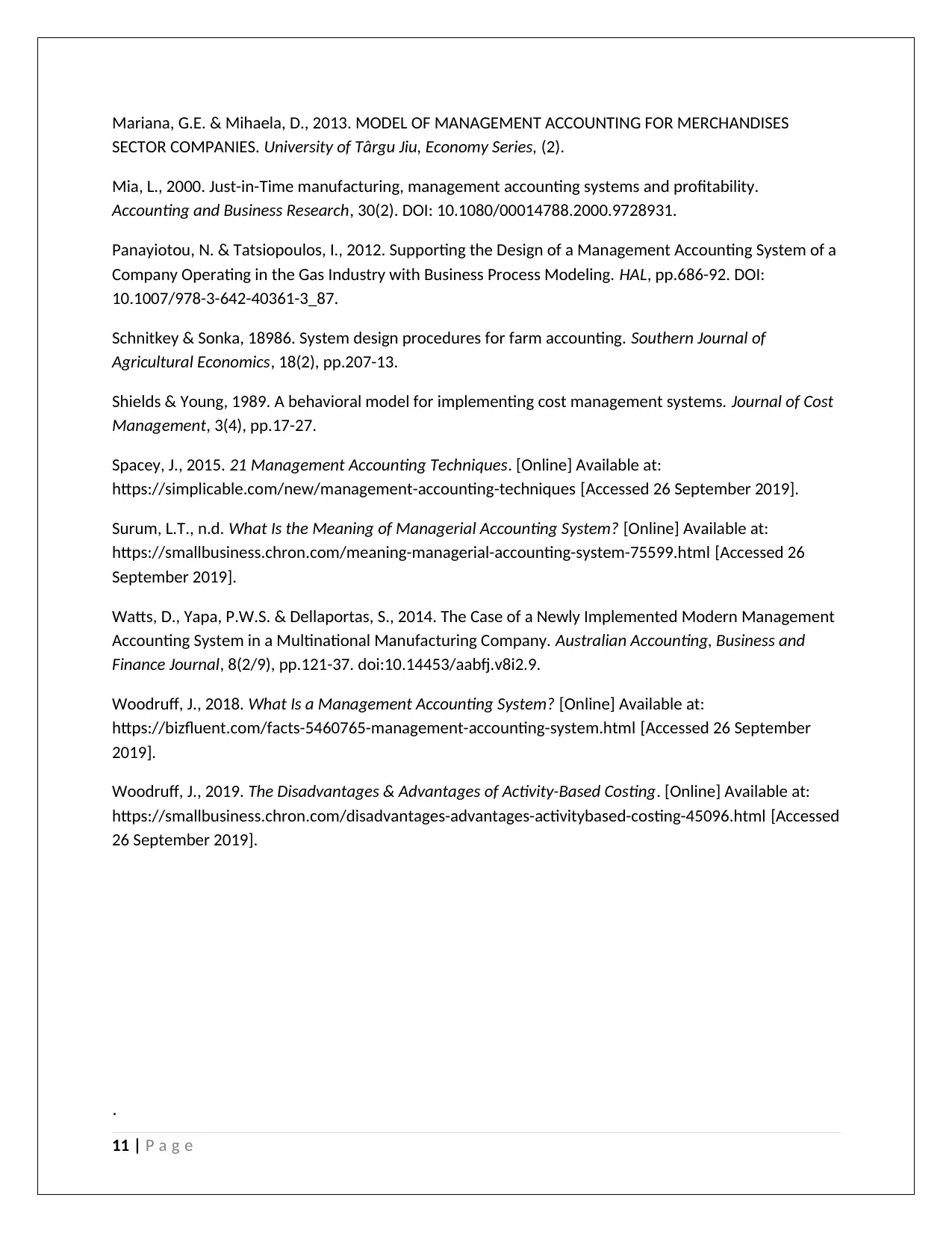
Mariana, G.E. & Mihaela, D., 2013. MODEL OF MANAGEMENT ACCOUNTING FOR MERCHANDISES
SECTOR COMPANIES. University of Târgu Jiu, Economy Series, (2).
Mia, L., 2000. Just-in-Time manufacturing, management accounting systems and profitability.
Accounting and Business Research, 30(2). DOI: 10.1080/00014788.2000.9728931.
Panayiotou, N. & Tatsiopoulos, I., 2012. Supporting the Design of a Management Accounting System of a
Company Operating in the Gas Industry with Business Process Modeling. HAL, pp.686-92. DOI:
10.1007/978-3-642-40361-3_87.
Schnitkey & Sonka, 18986. System design procedures for farm accounting. Southern Journal of
Agricultural Economics, 18(2), pp.207-13.
Shields & Young, 1989. A behavioral model for implementing cost management systems. Journal of Cost
Management, 3(4), pp.17-27.
Spacey, J., 2015. 21 Management Accounting Techniques. [Online] Available at:
https://simplicable.com/new/management-accounting-techniques [Accessed 26 September 2019].
Surum, L.T., n.d. What Is the Meaning of Managerial Accounting System? [Online] Available at:
https://smallbusiness.chron.com/meaning-managerial-accounting-system-75599.html [Accessed 26
September 2019].
Watts, D., Yapa, P.W.S. & Dellaportas, S., 2014. The Case of a Newly Implemented Modern Management
Accounting System in a Multinational Manufacturing Company. Australian Accounting, Business and
Finance Journal, 8(2/9), pp.121-37. doi:10.14453/aabfj.v8i2.9.
Woodruff, J., 2018. What Is a Management Accounting System? [Online] Available at:
https://bizfluent.com/facts-5460765-management-accounting-system.html [Accessed 26 September
2019].
Woodruff, J., 2019. The Disadvantages & Advantages of Activity-Based Costing. [Online] Available at:
https://smallbusiness.chron.com/disadvantages-advantages-activitybased-costing-45096.html [Accessed
26 September 2019].
.
11 | P a g e
SECTOR COMPANIES. University of Târgu Jiu, Economy Series, (2).
Mia, L., 2000. Just-in-Time manufacturing, management accounting systems and profitability.
Accounting and Business Research, 30(2). DOI: 10.1080/00014788.2000.9728931.
Panayiotou, N. & Tatsiopoulos, I., 2012. Supporting the Design of a Management Accounting System of a
Company Operating in the Gas Industry with Business Process Modeling. HAL, pp.686-92. DOI:
10.1007/978-3-642-40361-3_87.
Schnitkey & Sonka, 18986. System design procedures for farm accounting. Southern Journal of
Agricultural Economics, 18(2), pp.207-13.
Shields & Young, 1989. A behavioral model for implementing cost management systems. Journal of Cost
Management, 3(4), pp.17-27.
Spacey, J., 2015. 21 Management Accounting Techniques. [Online] Available at:
https://simplicable.com/new/management-accounting-techniques [Accessed 26 September 2019].
Surum, L.T., n.d. What Is the Meaning of Managerial Accounting System? [Online] Available at:
https://smallbusiness.chron.com/meaning-managerial-accounting-system-75599.html [Accessed 26
September 2019].
Watts, D., Yapa, P.W.S. & Dellaportas, S., 2014. The Case of a Newly Implemented Modern Management
Accounting System in a Multinational Manufacturing Company. Australian Accounting, Business and
Finance Journal, 8(2/9), pp.121-37. doi:10.14453/aabfj.v8i2.9.
Woodruff, J., 2018. What Is a Management Accounting System? [Online] Available at:
https://bizfluent.com/facts-5460765-management-accounting-system.html [Accessed 26 September
2019].
Woodruff, J., 2019. The Disadvantages & Advantages of Activity-Based Costing. [Online] Available at:
https://smallbusiness.chron.com/disadvantages-advantages-activitybased-costing-45096.html [Accessed
26 September 2019].
.
11 | P a g e

12 | P a g e
⊘ This is a preview!⊘
Do you want full access?
Subscribe today to unlock all pages.

Trusted by 1+ million students worldwide
1 out of 12
Related Documents
Your All-in-One AI-Powered Toolkit for Academic Success.
+13062052269
info@desklib.com
Available 24*7 on WhatsApp / Email
![[object Object]](/_next/static/media/star-bottom.7253800d.svg)
Unlock your academic potential
© 2024 | Zucol Services PVT LTD | All rights reserved.





